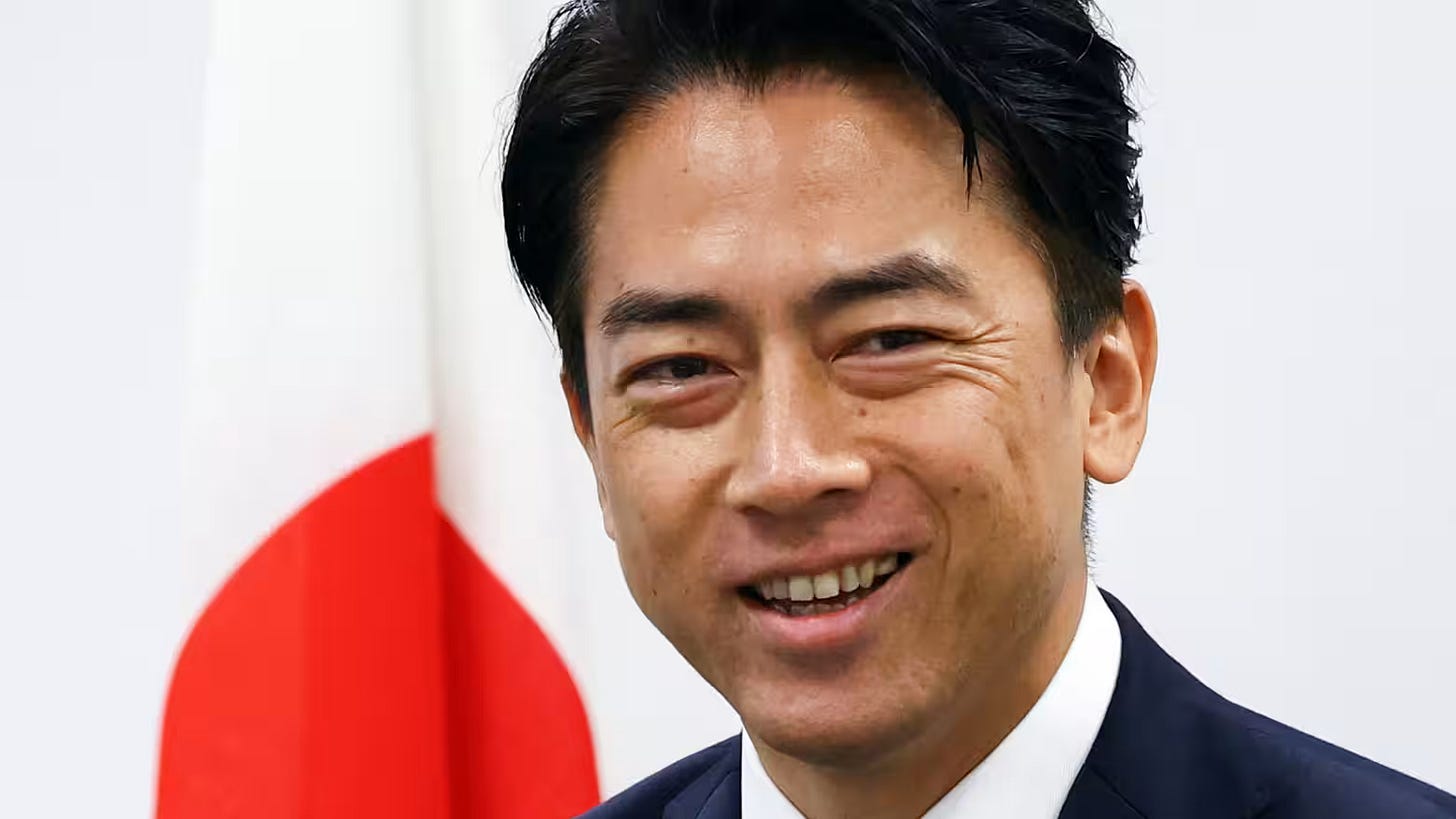LDP Election Special: Japan Gets a New Prime Minister
Iwakura predicts the next Japanese PM, and what victory means for Japan and Europe going forwards

The Japanese political scene is being set ablaze as we enter October.
The Liberal Democratic Party (LDP), the dominant force in Japanese politics since 1955, will tomorrow (or today if you’re in Japan), choose its next leader and, in all likelihood, the next Prime Minister.
Japan’s hopeful Prime Minister will find that the sweet taste of victory lasts agonizingly brief, however.
They will need to appease the LDP’s current coalition partners - the center-left Komeito, with whom they rule as a minority government, and secure enough ad-hoc support to win election in the National Diet.
Alternatively, they need to negotiate a new alliance, expanding the coalition to other members or building an entirely new coalition.
They will also have to navigate the cutthroat world of internal LDP politics - known for its intricate system of factions and plots, dominated by heavyweight personalities, and increasingly torn between the nationalist right and pacifist left.
All this to say; it’s not just a question of who takes power, it’s how they take power.
Whether it be the conservative firebrand Sanae Takaichi, the liberal centrist Shinjiro Koizumi, or the party old guard Yoshimasa Hayashi who ascends to the Kantei, the question of how Japan’s future will be shaped will ultimately be determined by the size of their victory, and how well they placate rebellious allies and woo skeptical partners.
And so with no further ado, let’s jump into this weeks LDP election special edition of Iwakura, where we’ll predict the next leader, analyze their path to the Kantei, and and scrutinize the consequences for Japan and Europe.
The Iwakura Prediction: It’s Complicated
Political commentators and journalists traditionally refrain from trying to call elections before they happen. Or, at least, they have since 2016.
It’s a fools game, everyone knows that. It can only result in embarrassment, bruised egos, and damaged credibility. Not to mention that politics can throw up a million unexpected surprises that can thwart even the most sound prediction. Just ask Nate Silver.
I am not Nate Silver, but I am a bit of a fool.
And so the official Iwakura prediction is that Shinjiro Koizumi will win the LDP leadership race and thus, become Japan’s next Prime Minister.
The young, centrist liberal is as close to a European-style politician that Japan is capable of producing, at least, if one still views Europe as a centrist continent.
With more of a hint of Macron about him, his European style net zero climate policies, relatively open attitude to migration (though all candidates have pledged to reduce it), and muted defense policy clashed with Takaichi’s American style skepticism of net zero, hardline approach to migration, and nationalist focus on the military.
But this is where it gets complicated - Koizumi may well win the election, but his politics will have suffered a loss.
Let me explain.
The Road to Election
If Koizumi does win tomorrow’s election, it will be rooted in his support from sitting National Diet members of the LDP, not the party rank and file.
The trick is in the procedure.
The first round of the LDP leadership race will take place between all five candidates who have entered the race. In this round, each member of the LDP party is allowed to vote for their first preference, allocating 295 votes proportionally to that vote.
At the same time, the elected politicians of the LDP in the national diet receive one vote each, allocating 295 votes for a total of 590 votes between the five candidates.
Polling of the LDP membership has consistently revealed a lead of several points for Takaichi over Koizumi, followed by Hayashi. If these polls hold up for the election she will lead Koizumi in the popular vote.
Ms. Takaichi, however, is on the wings of the party. A staunch right winger, she is extremely unpopular with the LDPs sitting politicians, outside of her direct factional support.
Neither Takaichi nor Koizumi are capable of reaching a majority in the first round, and so the top two candidates will immediately go to a runoff, which is calculated on the same day.
The rules in this second round are completely different. Whilst national diet members retain their 295 votes, rank-and-file members instead only allocate 47 votes - one for each of the 47 local chapters of the LDP, who distribute them according to how their members voted in the first round.
That makes a Koizumi victory an all-but-certainty in the second round, no matter what the party rank and file think.
His slight deficit in the popular vote is more than compensated by his popularity amongst the party’s serving politicians - with almost double the number of sitting politicians declaring their support for him in the first round, compared to Takaichi.
Factional Warfare
The scenario described above describes how things will go if there are no last minute surprises.
But there are more than a few of those last minute surprises waiting on the sidelines, ready to ruin any handsome young Substacker’s electoral prediction.
The LDP is legendary for its secretive, ever-changing, system of factions, that congregate around the personal figures of its political heavyweights.
It is rumored that two of the largest of those factions - the powerful Aso and Motegi factions, are planning to whip their followers to vote for Takaichi, which would be enough to thwart Koizumi’s campaign if her vote holds up in the rank-and-file.
Then there’s also the figure of the third placed outsider - Yoshimasa Hayashi, the continuity candidate of former PM Kishida’s faction.
If Hayashi and the Kishida faction were able to gather enough support from sitting MPs, they might well undermine Koizumi and snatch second place from under his nose, and providing a far more palatable candidate for many than the conservative firebrand Takaichi.
Intriguingly, the same could not be said were Hayashi to gain second place at Takaichi’s expense. In this scenario, Koizumi would be almost certain to win as the Aso faction would never vote for a Kishida faction.
Yes, I should explain that more, but by now I’ve overwhelmed you with names of obscure Japanese politicians and different factions. The story of those factions will have to wait for another day.

Size Matters
But beyond the potential for an electoral upset, Koizumi’s first big barrier after the LDP’s leadership election would be Japan’s electoral politics.
The defining feature of Shigeru Ishiba’s Prime Ministership was his relative lack of political space. It would be unfair to call him a lame duck, but he teetered on the edge of it.
The LDP’s partnership with its current coalition partner, Komeito, is simply too narrow. They are, after all, a minority government, and the LDP too broad an umbrella to rely upon, to have any degree of parliamentary stability.
Koizumi would have to find a way of appeasing both the hard right nationalists of the Takaichi wing of the LDP, who believes that Japan should rearm to challenge China, and the pacifist center left Komeito.
Koizumi will therefore seek to expand the coalition - and his prime candidate is Japan’s libertarian party, the Japan Innovation Party (Ishin no Kai), who have made Osaka a stronghold since their foundation.
Keen politics watchers might wonder how easy creating a coalition between a center left party that advocates for greater social spending, and a right leaning libertarian party that wants to slash social spending, will be, and, well, yes. It’s going to be as difficult as it sounds.
This is where the margin of Koizumi’s victory would come in.
Were he to rout Takaichi and surge to power on a wave of support, he would be able to employ the LDP heavyweights in seeking that coalition. He would command the support and respect of the party, turning the deal offered to Ishin from ‘Would you like to support a weak PM?’ to ‘Would you like to have a voice in the future of policymaking?’.
Size, it turns out, very much does matter.
Conclusion
So what does this mean for Europe? Well, as always, it depends.
Whilst there are only three viable winners of this election, there are an infinite number of possibilities for what the next government will look like. Different winners, different collations, different balances of power, all combine to make an impossible mélange of scenarios.
If the Iwakura prediction rings true, then a weak Koizumi scenario will appear. The hard, nationalist right, emboldened by a surge of popular support, will scupper the left-leaning policies that the coalition needs for its partners support.
Meanwhile, the surge of public support for anti-migrant, right wing rhetoric, will benefit Takaichi and the meteoric rise of Sanseito. Anger unaddressed is anger compounded.
In effect, we will be back to where we were with the Ishiba government - a weak parliamentary arithmetic that’s just enough to prop up a government, but not enough to enact bold reform.
For Europe, this means continuity. A Japan that remains a stable partner, but one too paralyzed to take meaningful action on migration, climate, or security.
And that can only mean one thing - the new Prime Minister will not be for long.


